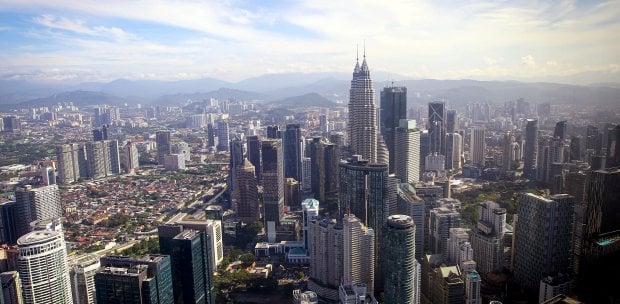Few countries have managed to match Malaysia's feat of transforming herself from a sleepy British colonial outpost to a roaring Asian Tiger within a few decades.
She is arguably one of the case studies of poverty eradication and wealth redistribution.
Malaysia is currently classified as an upper-middle income nation with a highly open economy. It is no coincidence that Malaysia was one of 13 countries identified by the Commission on Growth and Development of the World Bank to have recorded an average growth of more than 7 percent per year for 25 years or more in its 2008 Growth Report.
The World Bank was unequivocal in their assessment of Malaysia. According to them economic growth was inclusive, as Malaysia also almost succeeded in eradicating hard-core poverty: the share of households living below the national poverty line fell from over 50 percent in the 1960s to approximately 5.0 percent currently.
At the threshold
On the road towards achieving Madani Economic Narrative (MEN) in less than 10 years that would see Malaysia transform to become a high-income and fully developed nation. We now reflect our previous achievements in the Tenth and Eleventh Malaysia Plan (10MP & 11MP) while trying to realise the promises of the Twelfth Malaysia Plan (12MP).
Incidentally the 12MP is the penultimate of the five year plans before 2030 while the MEN is a long-term economic plan, as it replaces the Shared Prosperity Vision 2030 (SPV2030).
Broadly, the aims and goals of the MEN arepropositioned to make Malaysia more competitive globally and regionally, especially with the setting up of the ASEAN Economic Community (AEC).
Limitations of Economic Modelling
While it is anticipated that fulfilling the World Bank's definition of a high-income economy based on Gross National Income (GNI) per capita will not be an issue. However can historical performance predict future performance? It can be argued that past performance does not guaranty future performance. This because the cornerstone for projections is based on economic modelling. Extrapolating from current trends is only reliable when predicting growth in the next year and the following year, however once the timeline gets longer, such assumptions certainly become more questionable.
In this context, the transformation in economic structure is vividly illustrated through Input-Output (I-O) technique. Analysis conducted on the I-O table, which contains a detailed account of transactions of goods and services between producers and consumers in the Malaysian economy will reveal the shift in the economic structure.
The input-output table is a comprehensive matrix that illustrates the inter-industry relationships by showcasing how the output of one industry becomes the input for another. This table helps in understanding the flow of goods and services across various sectors of the economy, revealing the intricate connections and dependencies between different industries and final consumers. The input-output table is a valuable tool for economists, policymakers, and analysts to analyze the structure and dynamics of an economy.
Despite undergoing a rapid economic transformation, there remains the possibility that the pace of such swift economic development may not be sustainable, potentially resulting in a deceleration of economic growth. Similar occurrences have been observed in the economies of several nations globally. The deceleration is linked to various causative factors, such as the persistent widespread use of outdated technologies without the vital necessary upgrades, commonly referred to as 'technological obsolescence.' Consequently, the economy fails to thrive and, instead, experiences stagnation.
Economic rejuvenation is therefore what is needed is to bypass this stagnation. For example the American economy keeps on growing because of the immense degree and amount of technological innovation that is taking place. Had it not been for this rejuvenation, the economy in the USA would have been stuck in a rut, outpaced by more innovative new players. Undeniably a lot of the groundbreaking work in new fangled technologies such as genomics, artificial intelligence, computing to name few, originates from the USA.
To be fair, when it comes to projecting future growth, economic modelling can offer only so much guidance. These models predict future economic outputs on the basis of projected future levels of economic inputs, but future economic inputs are impossible to predict. In the end, there is little to do but extrapolate from current inputs. But inputs, as well as other key features of any economy, change over time. Malaysia's economy has transformed rapidly but at some point in the future, high growth rates might level out and her economic growth slow down, in other words the rate of growth decelerates before eventually reaching a steady-state phase.
Economically Dynamic Region
Fortunately, Malaysia is located in an economically dynamic region, as ASEAN has emerged centre stage in the global economy and has been recognised as one of the most dynamic regions in the world. All the countries in our region adopt open economic and social systems that encourage trade, investment, travel and communications. At this moment in time, our region is the fastest growing in the world. Thus we can benefit by riding on ASEAN's intrinsic strengths and prospects. In that way our economic performance would be vastly better than that of the world average.
However, looking inwards, an introspection will reveal that there are regional disparities. Philosophically we can argue that some regions are at a disadvantage due to geographical reasons and historical legacy. In addition to poor physical connectivity (i.e. road networks, railways and ports) that will also impede economic growth.
Indeed, upon careful examination, research findings reveal imbalances in development and growth. Certainly, certain regions in Malaysia find themselves in relatively remote geographical positions, compounded by the lingering negative effects of colonial legacies.
Additionally, physical connectivity, including road networks, railway lines, and ports, plays a crucial role in fostering economic activities. The latest addition to this is internet accessibility, which, if left unaddressed, could widen the digital gap between regions. It is undeniable that when the residents of a region can connect and transact, economic activities, namely the production of goods and the provision of services, will ensue. This is what is accounted for as the economic output of a region.
Five states/regions contribute approximately 62 per cent of Malaysia's Gross Domestic Product (GDP), namely the Federal Territories of Kuala Lumpur, Selangor, Penang, Johor, and Melaka. What about the other nine states? It is worth noting that around 49 per cent of Malaysia's population resides in these states. The development gap between states/regions cannot be ignored. It has the potential to become more pronounced and extreme. It is crucial to address this issue before Malaysia is recognised by the World Bank as a high-income economy. In this context it would be terribly unfortunate if some regions' residents feel left behind, trapped in the cocoon of the third world.
As alluded to earlier, statistics indicate that by the year 2030, only a few states will achieve the target of becoming high-income economies within the planned timeframe, while others will take longer to reach this goal. The lagging states require attention from both the Federal and State Governments to grow at a faster rate to avoid falling behind. Imbalances in growth must be taken into account when formulating development plans. There should be no neglect in the economic development of regions.
Together, let us build the economy, and political differences should not be obstacles to balancing development and growth. Failing to address these disparities would render the attainment of developed nation status meaningless for the Rakyat.
Not becoming a Statistical Mirage
It is not an exaggeration to say that we could become a case study of a 'Statistical Mirage', where the benefits of growth and progress are concentrated in a specific physical location and among certain segments of society only.
Have we done enough to correct these imbalances? Make no mistake that national integration would be a futile endeavour should there exist glaring disparity. What the statistics tell us is that while some states will definitely achieve developed status and enjoy a high income-economic within the set time frame, others will take a much longer time. These states need assistance to help them develop at a faster pace. All of these bear implications for economic development policies both at the Federal and State levels.
Malaysia is more blessed than other countries in terms of its development potential. We have a favourable resource base because our land area relative to population is favourable. Geographically, we are situated safe from frequent natural disasters like earthquakes and typhoons. We have a multicultural population with the diversity that facilitates the absorption of the best values from each community. We have the legacy of a colonial administration from the British with their high sense of law and order. We are situated in a region where our neighbours are progressive minded, an attitude of mind which transcends boundaries and gives energy to our development.
In the final analysis, if we were to achieve regional economic integration in ASEAN, we must first put our house in order. There should be seamless connectivity underpinned by strong institutions in Malaysia.
*The writer currently serves as a Senior Consultant at Global Asia Consulting (GAC) and has a background as a senior researcher at the Malaysian Institute of Economic Research. He has been engaged as a consultant for government agencies and international institutions. The viewpoints articulated are solely those of the author.





